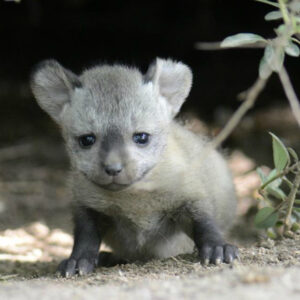The Bat-eared fox, (species Otocyon megalotis), large-eared fox, that belong to the dog family (Canidae), found in open, arid areas of eastern and southern Africa. It has 48 teeth, 6 more than any other canid. The bat-eared fox is like the red fox in appearance but has unusually large ears. It is yellowish gray with black face and legs and black-tipped ears and tail. It grows to a length of about 80 cm (32 inches), including a 30-centimetre (12-inch) tail, and weighs from 3 to 4.5 kg (6.6–10 pounds). It lives alone or in small groups and feeds primarily on insects, especially termites. Litters contain two to five young; gestation lasts 60 to 70 days.
LIFE SPAN
Up to 13 years in expert care; unknown in the wilderness
YOUNG
Gestation: 60 to 75 days
Litter: Up to 6 kits (pups)
Weight at birth: 3.5 to 5 ounces (99 to 142 grams)
Maturity: Fully grown at 6 months; females sexually mature at 18 months
LIFE SPAN
Up to 13 years in expert care; unknown in the wilderness
YOUNG
Gestation: 60 to 75 days
Litter: Up to 6 kits (pups)
Weight at birth: 3.5 to 5 ounces (99 to 142 grams)
Maturity: Fully grown at 6 months; females sexually mature at 18 months
SIZE
Length: 18 to 26 inches (46 to 66 centimeters)
Height at shoulder: 12 to 16 inches (30 to 40 centimeters)
Tail length: 9 to 13 inches (23 to 34 centimeters)
Weight: 7 to 12 pounds (3.2 to 5.4 kilograms)
FUN FACTS
A male fox is called a dog, a female is a vixen, and babies are called kits or pups.
Bat-eared foxes are sandy gray with lighter fur on the belly and darker fur around the eyes, muzzle, back of the ears, feet, and tip of its long, bushy tail. The inside of the ears and a band across the forehead are white or buff.
Bat-eared foxes don’t seem to mind sharing their territory. Up to 72 foxes have been recorded in 1 square mile (2.6 square kilometers).
The scientific name for the bat-eared fox is Otocyon megalotis. It is from the Greek words “oto/Otis” (ear), “cyon” (dog), and “mega” (big)—and basically means eared dog with big ears.
HABITAT AND DIET
In the short-grass savannas and scrublands of eastern and southern Africa, it’s not unusual to find groups of bat-eared foxes occupying the same area, something uncommon among other wild dogs. Their wide habitat range matches that of their favorite food, the harvester termite. Bat-eared foxes usually live in groups of 2 to 5 individuals that have overlapping territories of almost 200 acres (80 hectares).
A bat-eared fox family has several den holes in its territory, each with many entrances, tunnels, and chambers. The foxes’ claws are made for digging, and they can create their own burrow or enlarge an empty one made by other wildlife. They are even known to use old termite mounds as dens. The den is a protected area where the group sleeps and also where the females give birth. Predators that prey on bat-eared foxes include eagles, jackals, and hyenas.
Yes, this fox eats insects, with termites making up to 70 percent of its diet. Besides termites, which it licks up from the ground, the bat-eared fox eats dung beetles and their larvae, grasshoppers, scorpions, spiders, millipedes, rodents, lizards, fruits, and eggs. But insects make up the main part of its diet.
Bat-eared foxes have more teeth (46 to 50) than most mammals, and that’s what sets them apart from other foxes. While other members of the dog family have two upper and three lower molars on each side of the mouth, bat-eared foxes have three upper and four lower molars. Specialized teeth chew their creeping, crawling food, and those huge ears can listen for insects moving around.
Can you hear beetles crawling? Bat-eared foxes find prey by walking slowly with their nose close to the ground and ears cocked. Once they locate the insects by sound, the foxes jump or dig quickly to catch them and crunch them up for a tasty, high-protein meal. Bat-eared foxes hang around hoofed mammals, because from those comes poop—and insects come buzzing around the droppings, providing a ready feast for the foxes. These little canids sometimes travel up to 7.5 miles (12 kilometers) each night when looking for food.
Bat-eared foxes at the San Diego Zoo and San Diego Zoo Safari Park eat a fortified meat-based commercial carnivore diet, dog kibble, a small mouse, mealworms, and crickets. Wildlife care specialists say mealworms are their favorite—like fox candy!
Showing the single result


